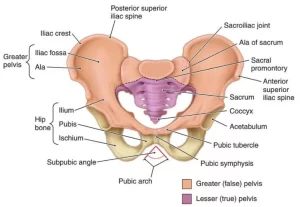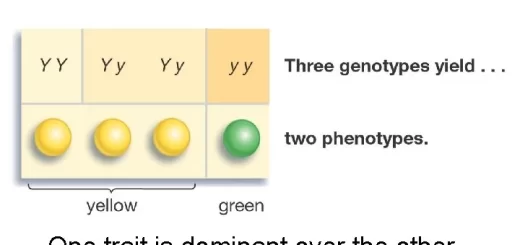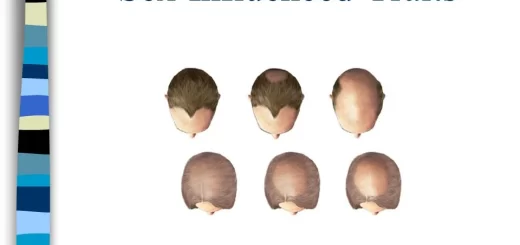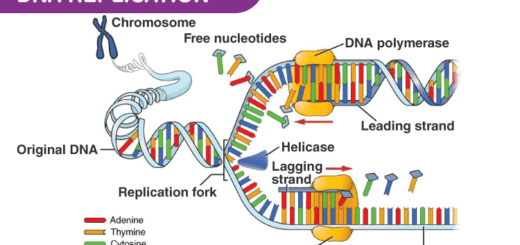Bony pelvis structure, types, organs, Differences between male and female pelvis
The bony pelvis consists of 2 hip bones (anterolaterally) & a sacrum & coccyx (posteriorly). The 2 hip bones articulate anteriorly to form the symphysis pubis (secondary cartilaginous joint) and posteriorly with the sacrum to form the sacroiliac joint (synovial plane joint).
Normal anatomical position of the pelvis
It is that the anterior superior iliac spine and the pubic tubercle are at the same vertical plane, while the tip of the coccyx and the upper border of the symphysis pubis are at the same horizontal plane.
Sacrum
It is a triangular bone formed of 5 fused sacral vertebrae. It has a base, an apex, and three surfaces. The base is directed upwards, formed of the body of the 1st sacral vertebra and ala of the sacrum (the expanded transverse process of the 1st sacral vertebra). It articulates with the 5th lumbar vertebra through the intervertebral disc at the lumbosacral joint. The anterior projecting border of the body of the 1st sacral vertebra is known as the sacral promontory.
Apex: directed downwards &, articulates with the coccyx.
Pelvic surface: It is concave, smooth, and directed forwards and downwards. It shows 4 pairs of ventral sacral foramina, for passage of ventral rami of sacral nerves.
Structures attached to the pelvic surface of the sacrum
Four structures related to the ala of the sacrum from medial to lateral:
- Sympathetic chain.
- Lumbosacral trunk (L4,5).
- Obturator nerve.
- Iliolumbar artery.
Other structures
1- Three viscera:
- Pelvic Colon, to the upper 2 pieces.
- Pelvic Mesocolon, its medial limb (inverted shape) is attached to the upper 2 pieces.
- Rectum, related to lower 3 sacral vertebrae.
2- Three vessels:
Lateral sacral arteries, enter the ventral sacral foramina, (right and left). Median sacral artery, to the midline of the pelvic surface. Superior rectal (right and left).
3- Nerves:
Ventral rami of upper 4 sacral nerves (right and left).
Lateral surface
- Its upper part shows an ear-like smooth articular surface called auricular surface, for articulation with the ilium to form the sacroiliac joint.
- It has a rough area behind the auricular surface for the attachment of the interosseous sacroiliac ligament.
- The narrow lower part is for the attachment of the sacrotuberous, sacrospinous and posterior sacroiliac ligaments
Dorsal Surface
- The dorsal surface is convex and rough.
- It presents 4 posteriors (dorsal) sacral foramina on each side They give exit for the dorsal rami of the upper four sacral nerves and terminal parts of the lateral sacral arteries.
- The tubercles in the median plane are called the spinous tubercles as they represent the fused spines of the sacral vertebrae and form together with the median sacral crest.
- The tubercles on the medial sides of the posterior sacral foramina are called the articular tubercles as they represent the fused sacral articular processes and form together the intermediate sacral crest.
- The tubercles on the lateral sides of the posterior sacral foramina are called the transverse tubercles as they represent the fused sacral transverse processes and form together the lateral sacral crest.
The sacral canal
The sacral canal is the lowest part of the vertebral canal. It begins by a triangular opening posterior to the body of the first piece of the sacrum. The canal ends by an opening called the sacral hiatus which lies on the dorsum of the last piece of the sacrum. The sacral hiatus is bound laterally by two projections called the sacral cornua, one on each side.
Contents of sacral canal
- Dura and arachnoid mater with subarachnoid space containing cerebrospinal fluid. It ends opposite the second piece of the sacrum.
- Roots of sacral nerves (5 pairs) and coccygeal nerves (1 pair) (cauda equina).
- Filum terminal: a glistening white fibrous thread descends as an extension from the pia mater of the lower end of the spinal cord.
- Lateral sacral arteries, four pairs & internal vertebral venous plexus Loose areolar connective tissues.
Structures that get exit from the sacral hiatus
- Fifth pair of sacral nerves.
- One pair of coccygeal nerves. Filum terminale. It gets the attachment to the back of the first piece of the coccyx.
The pelvic cavity
The cavity of the pelvis is divided into:
- Greater pelvis = false pelvis = lies above and in front of the level of the pelvic inlet (it is a part of the abdominal cavity).
- Lesser pelvis = true pelvis = lies below and behind the level of the pelvic inlet.
Lesser pelvis (True pelvis)
The cavity of the true pelvis has an inlet and an outlet.
Boundaries of the pelvic inlet (pelvic brim)
From posterior to anterior:
- The promontory of sacrum…posteriorly.
- Ala of sacrum.
- Arcuate line. → On either side (linea terminalis).
- Pectenpubis. → On either side (linea terminalis).
- Pubic crest.
- Upper border of symphysis pubis… anteriorly. The plane of the pelvic inlet forms an angle of 60° with the horizontal plane.
Boundaries of pelvic outlet
- Lower border of symphysis pubis: anteriorly.
- Apex of coccyx: posteriorly.
- Ischial tuberosity, sacrotuberous ligament, and side of the pubic arch on each side.
Cavity of the true pelvis
Boundaries:
- Anterior and inferior: symphysis pubis, 2 pubic bones, and pubic arches.
- Posterior and superior: ventral concave surface of sacrum and coccyx.
- Laterally: pelvic surfaces of ilium and ischium, below the level of the pelvic inlet (arcuate line).
Differences between male and female pelvis
Male pelvis
- Pelvic inlet: Heart-shaped.
- Pelvic outlet: Narrower
- Pubic arch: Narrow forming an acute. Its margin is more everted.
- Symphysis pubis: Long.
- Pelvic cavity: A long segment of a short cone.
- Sacrum: Body: ala = 2:1, Ventral surface is more curved, Long, and narrow, Auricular surface is opposite upper 3 sacral pieces.
- Pre-auricular sulcus: Less apparent.
- Greater sciatic notch: Deep and narrow.
- Ischial tuberosity: Inverted.
- Ischial spine: projects more inwards.
- Coccyx: Projects forwards.
- Acetabulum: Wider than the female.
- Diameters of inlet and outlet: Inlet (A/P diameter= 10cm Transverse diameter= oblique=12cm), Outlet (A/P diameter= 8cm Transverse diameter= 8.5cm.
- Obturator. foramen: Oval and large.
Female pelvis
- Pelvic inlet: Round or oval
- Pelvic outlet: Wider
- Pubic arch: Wide forming an obtuse. Its margin is not everted
- Symphysis pubis: Short
- Pelvic cavity: Short segment of a long cone.
- Sacrum: Body: ala 1:1, Ventral surface is less curved, Short and broad, Auricular surface is opposite 2.5 sacral pieces.
- Pre-auricular sulcus: More apparent
- Greater sciatic notch: Wide and shallow
- Ischial tuberosity: Everted.
- Ischial spine: Projects more outwards.
- Coccyx: Projects backwards.
- Acetabulum: Narrower than the male.
- Diameters of inlet and outlet: Inlet (A/P diameter= 11cm transverse diameters= 13cm. Oblique diameter= 13cm, Outlet (A/P= transverse diameter= 11cm).
- Obturator. foramen: Triangular and small
A/P Anteroposterior diameter
General organization of the pelvic organs
Arrangement of the pelvic viscera in female (from posterior to anterior):
- Pelvic (Sigmoid) colon: It lies in the upper posterior part of the pelvic cavity. It is attached to the sacrum by its mesocolon.
- Rectum: It lies in the lower posterior part of the pelvic cavity and follows the concavity of the sacrum and coccyx.
- Anal canal: It begins at the recto-anal angle and runs down and backwards to the end as the anus.
- Uterus: projects through the interval between the rectum and urinary bladder. Its free end (fundus) is directed anteriorly. Its lower end (cervix) opens into the vagina.
- Vagina: It descends between the urinary bladder and urethra anteriorly, and the rectum and anal canal posteriorly.
- Broad ligament: It is a fold of peritoneum that stretches from the sides of the uterus to the side wall of the pelvis on each side the uterine tube, on each side, runs in the free anterior border of the broad ligament. The ovary lies on the upper surface of the broad ligament near the side wall of the pelvis.
- Urinary bladder: It lies in the lower anterior part of the pelvic cavity, behind the symphysis pubis and the pubic bones.
- Ureter: it runs on the side wall of the pelvis behind the peritoneum. It curves forwards, running below the broad ligament to join the urinary bladder.
Arrangement of the pelvic organs in male
- Pelvic (sigmoid) colon: lies in the upper posterior part of the pelvic cavity.
- Rectum: following the concavity of the sacrum and coccyx. It occupies the lower posterior part of the pelvic cavity.
- Anal canal: begins at the recto-anal angle and descends urinary bladder down and backwards to end as anus.
- Urinary bladder: lies in the lower anterior part of the pelvic cavity, above and behind the symphysis pubis and pubic bones.
- Ureter: descends on the side wall and curves forwards and medially to join the bladder
- Vas deferens: from the deep inguinal ring, it runs down and backwards on the side of the pelvis. It curves medially across the ureter to reach the base (back) of the urinary bladder.
- Seminal vesicle: lies between the rectum and the base of the urinary bladder.
- Prostate gland: lies below the urinary bladder and anterior to the lower end of the rectum (ampulla of the rectum).
You can follow Science Online on Youtube from this link: Science online
You can download Science Online application on Google Play from this link: Science online Apps on Google Play




